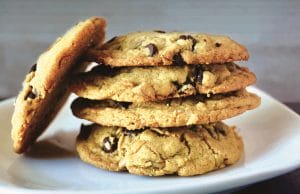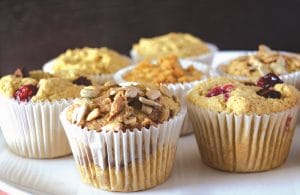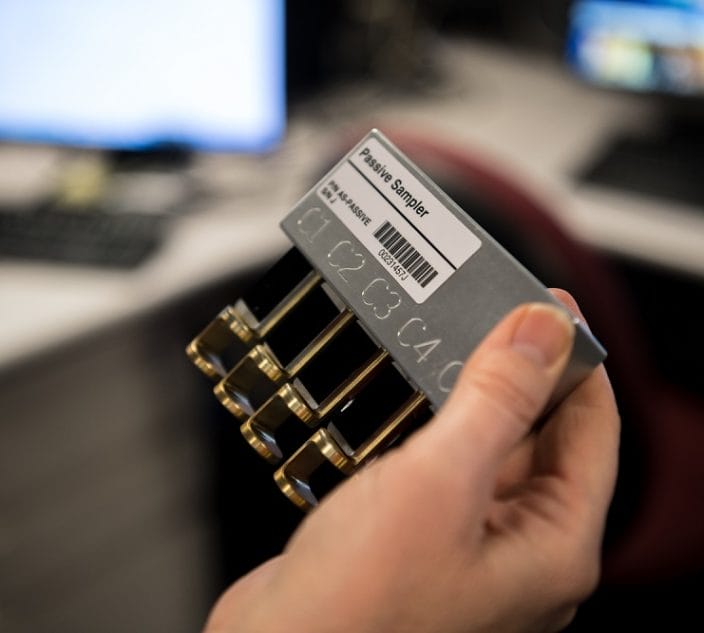It’s high time to simplify things in the gluten-free pantry. A few essential ingredients can bring outstanding results – from cookies to cakes, muffins and more.
ONCE upon a time, gluten-free baking meant rice flour everything. While that didn’t remedy the dry, crumbly consequences, it certainly was simple: just substitute rice flour for wheat flour 1-to-1 – and hope for the best.
But as the demand for better gluten-free goods grew, new flours were milled, mixes and powdered replacers flaunted solutions, and grocers created aisles devoted to the cause. Things have become complicated – when all we really want are tasty baked goods – without complication.
I know some people with 20-plus flours and extras in their pantry, but the truth is, this isn’t required. A few new ingredients along with traditional staples can get you far with the right ratios. Here’s what you need for great gluten-free baking without searching for an elusive ancient grain or specialized, internet-only ingredient.
The Essentials for Gluten-Free Baking
Flours
Flour combinations are the pantry backbone to avoid dense cakes and dry cookies. Successful gluten-free baking – especially if allergens like eggs are omitted – requires a balance of flours. These flours vary in taste and texture, and their differing proteins, fiber, fat, and starchiness congregate to make up for missing gluten. For best results, your pantry needs a trio. Flours used solo may lack structure, produce undesirable textures, have a decreased shelf-life or leave an aftertaste.
Foundation flour: This key ingredient needs neutrality in both taste and composition. It’s this framework that offers structure and smooth texture. I recommend sorghum flour. It has a similar macronutrient composition to wheat, plus it’s versatile, consistent and inexpensive.
Second flour: Adding a second flour with a moderate/high protein content adds further structure and balances flavor. Teff flour or millet flour are my top picks. They differ in taste, and work well in nearly all applications. For each 1/4 cup of millet flour, use 3 tablespoons of teff flour.
Last addition: A starchy flour rounds out the threesome. Starches assist in binding, provide lightness in cakes and a desirable “chew” in breads and pizza dough. Tapioca flour, also called tapioca starch, is my go-to, complementing nutrient-rich sorghum, and millet or teff.
Binder
Xanthan gum bonds baked goods, doing the job of the gluten protein, but without the gluten. It’s readily available, and consistent in its results, making it a top pantry pick. While pricey, only a little added to the flour mixture produces big results.
The Standbys
Sugar
Special sugars aren’t needed for the everyday pantry. Different sugars can enhance flavor or texture, but granulated white sugar, dark brown sugar, and confectioners’ sugar can tackle everything.
Fat
Good taste, texture and shelf-life of baked goods depend on fat. A mild olive oil works with any baked good and, when a butter replacement is needed – e.g. for pastries, shortbread, buttercream – use dairy-free “buttery” margarine, such as Earth Balance Buttery Spread, which has a water percentage similar to butter.
Liquids
Vinegar is an essential liquid for gluten-free baking – especially when other allergens are omitted. It’s like taking gluten (for structure), egg (for lift) and buttermilk (for tenderness), in a spoonful of magic.
If you need a swap for milk, water can do, but a dairy-free “milk” with fat (such as coconut beverage) provides tenderness and adds shelf life.
Leaveners
Baking powder and baking soda produce lift and volume, working solo or alongside each other for nearly all baked goods.
Flavor
From spices to extracts to syrups, flavor options are limitless. Unsweetened cocoa powder, vanilla extract, ground cinnamon, and a few mix-ins (dried fruit, chocolate and seeds) add an appealing variety to any pantry.
The Extras
For additional options without straying too far from the staples, I keep these in my pantry.
Ground flaxseed adds moisture, shelf life and structure. For some recipes, it can be used for eggs (3 tablespoons liquid plus 1 tablespoon ground flaxseeds equals 1 egg), and add fiber and healthy fats.
Psyllium powder also brings those benefits, along with soluble fiber. For some recipes, it can be used instead of xanthan gum (1 teaspoon psyllium powder equals 1/2 teaspoon of xanthan gum).
Coconut oil can be substituted for butter or oil, and the virgin variety adds a hint of sweetness. 1 cup butter = 3/4 cup coconut oil (solid or liquid) for best success.
Club Soda (or sparkling water) gives additional lift, and works well for breads, muffins, and cakes. Use it in place of water or other liquids.
Putting Gluten-Free Baking Into Practice
It’s not just ingredients that help keep things simple. It’s recipes, too. I highly advocate “mix-mix-pour” recipes.
These recipes follow a basic protocol: 1. Mix the wet and dry ingredients separately. 2. Mix them together. 3. Pour the combination into the pan … just as your oven is preheated.
Flour measuring: Since measuring flours requires accuracy, the recipes linked below include the weights of the flours, and using a scale is recommended. If you don’t have a scale, measure by volume using the spoon-and-level method.
The mix-mix-pour recipes below get you started with some must-have basics: a chewy-on-the-edges and soft-in-the-middle cookie, a chocolate cake frosted with ganache, and a moist, tender muffin. With these, you’ll master a trio of foolproof recipes that require little technique and time, and soon be able to venture into your own variations.
Related Recipes
Easy Drop Cookies – No Nuts, Dairy, Egg or Gluten
Dairy-Free, Gluten-Free Chocolate Cake with Ganache
Customizable Allergy-Friendly, Gluten-Free Muffins
Laurie Sadowski is the author of three cookbooks devoted to gluten-free, allergy-friendly and vegan baking. Visit Lauriesadowski.com for more information.








